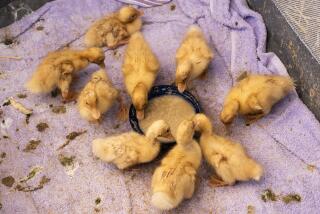Official to Count Peafowl in Colony
- Share via
A Ventura County Animal Control official said Tuesday he may have a solution to the problem of wild peafowl that have some of those living near the Santa Susana Pass at odds with each other.
Many residents describe the birds as landmarks and ecological assets. But others are no fans of the birds, which squawk loudly during breeding season, eat bushes and gardens and leave droppings.
Patrick Musone, an animal control education officer, said he plans to head into the boulder-strewn foothills of the pass and onto residents’ property today with his Irish wolfhound to get an idea of how many birds are there.
He said he will then meet with residents and determine how many, if any, of the birds should be relocated from the area to the Wildlife Way Station, a refuge for all sorts of exotic animals in the Angeles National Forest.
Six weeks ago, animal control employees and residents rounded up nearly 30 of the birds and took them to the wildlife refuge.
Musone said he and his pet, Big Dog Romeo, “are going to walk the knolls and we’re going to start counting birds in trees and birds on the ground and get an idea” of their population.
He is also waiting to hear from the state Department of Fish and Game to find out whether the birds, which are native to India and Africa, are now considered indigenous to eastern Ventura County.
If the peafowl are now considered native to the Santa Susana foothills, state law would prohibit them from being removed, Musone said. By some accounts, peacocks have roamed the area since the late 1950s.
One fed-up resident, who declined to identify himself or discuss the matter, got animal control to place a trap on his property, hoping to round up more birds.
Some neighbors who like the peacocks have thrown rocks and footballs near the trap to scare the birds away and keep them from being caught.
More to Read
Sign up for Essential California
The most important California stories and recommendations in your inbox every morning.
You may occasionally receive promotional content from the Los Angeles Times.










